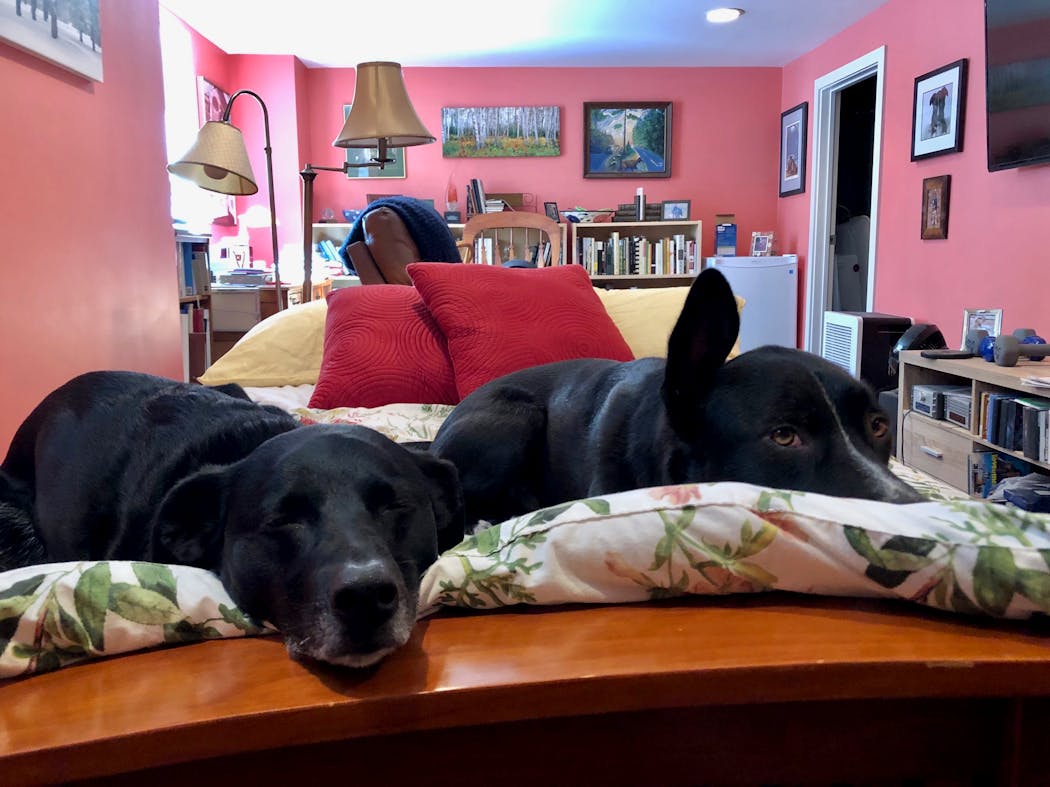On a gold-and-blue September afternoon, I'm lounging on a pontoon as it putters across a lake in western Minnesota. I should be blissfully watching the loons or admiring the pelican my husband spots at the end of a dock. But instead I am surreptitiously checking my phone.
This visit to see my husband's sister is the first trip we have taken without the dogs since 2019, and I am anxious. Angus and Rosie are at home, waiting for the dog sitter to arrive, and I am two hours away, waiting for her to text me that all is well.
She's due at our house anytime, and I'm worried about Angus. Since COVID-19, he has grown enormously protective of our home. The sitter knows him — we have spent a lot of time ensuring that — but she has never entered our house when we weren't there. Will she be OK? Will Angus jump on her without realizing who she is? We agreed not to kennel them, but should I have anyway?
In years past, when we had different, easier dogs, my husband and I traveled a lot. Sometimes our vet-student neighbor watched our dogs. Sometimes we swapped dog-sitting duties with friends. But Angus has made those kinds of arrangements impossible. He is highly reactive, he doesn't like other dogs, and since COVID he has grown less sociable.
Two years of having nobody inside our house taught him that nobody should ever be inside our house. As COVID lifted and we began having company again, he grew impossible. People he'd known and loved before lockdown he seemed to no longer recognize. He has never bitten, but he barked and lunged at everyone. We had to kennel him for every visit.
I felt trapped. If nobody can come into our house, how will we ever travel again?
And then I found a pet-sitter, a calm, intelligent, dog-loving woman who had experience with dogs like Angus. Well, maybe not dogs exactly like Angus — he is definitely one of a kind — but experience with difficult dogs.
In January, she began coming over every Sunday, and we worked to familiarize Angus with her. This was not easy. For the first few visits, we all stayed outside and kept Angus a good 30 feet away from her.
He gave her the hard stare and barked. She ignored him, which was exactly what he needed.
As winter turned to early spring we slowly closed the gap between us from 30 feet to 20, to 10. By blossom time, she was able to walk right beside Angus and me.
We then began walking into the yard — the pet sitter first, because Angus does not like to be followed. He watched with great nervousness as she opened the gate and walked into the yard, but over time, he grew used to having her there. Then we moved into the house.
By full summer, he had grown to trust her. We sat in the yard or the living room and he approached her for scratches and treats.
One day in early August she stayed in the house while we ran errands. I worried — oh, this dog has made me such a worrier — but everything was fine. Angus lay down at her feet and fell asleep.
And so we boldly planned the trip to western Minnesota. We would be gone three nights, and if all went well we could start planning bigger trips for next year. Ireland! We'll finally hike Donegal.
But first the pet sitter had to get through the door.
The pontoon was halfway around the lake when my phone dinged. "They greeted me with barks and lots of excitement but since then have settled down," she texted. She included two pictures — Angus in the back yard, one ear straight up, as always, and Rosie, eyes saying "Give me food!" as always.
I read the text and looked at the pictures. I lay back in the pontoon and looked up at the sky. Ireland in 2023, I thought. Those dogs are in good hands.
Laurie Hertzel is a dog lover, not a dog expert. She has been documenting the life of her reactive rescue pup Angus since he was 4 months old. Read them all at www.startribune.com/puppy.
Israelis grapple with how to celebrate Passover, a holiday about freedom, while many remain captive
A Georgia beach aims to disrupt Black students' spring bash after big crowds brought chaos in 2023
Today in History: April 18, San Francisco's great earthquake sets off fires, thousands die



